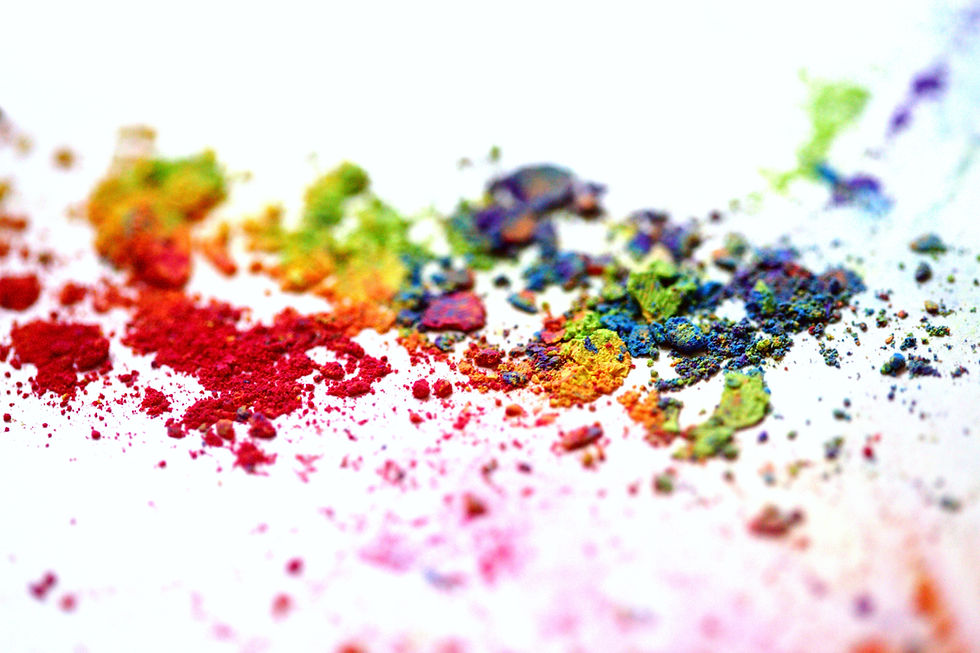Cyan, a lively, balanced and fresh greenish shade of blue
- Laura Longoni

- Mar 29, 2024
- 3 min read
Updated: Mar 6

This is my sixth first stop during my journey to discover every single colour of the colour wheel and it will be all about the colour cyan and its related shade turquoise.
Cyan, made of 50% blue and 50% green, appears as a very vibrant greenish blue which represents the colour gradation from blue to green.
It is one of the primary colours in the subtractive colour mixing model CMY(K) and sometimes it is called “process cyan”. In the subtractive colour mixing model RYB it is considered a tertiary colour and in the additive colour mixing model RGB it is considered a secondary colour generated from the union of blue and green.
Even though it is considered a shade of blue with a greenish tendency, scientists have come to the conclusion that it is a primary and chromatic colour due to the fact that what Newton identified as blue in reality corresponded more to a blue-green colour that today we call turquoise or cyan.
In this post I will talk about the origin of the colour name itself, its meaning in psychology and symbolism, the most important pigments and shades for art.
Where does the colour name "Cyan" come from?
The word Cyan derives from an old Greek word “kyanos” used to indicate a deep blue shade or lapis lazuli. Sometimes the colour Cyan is also referred to as Aqua.
What does the colour cyan mean in psychology?
Cyan is usually associated to liveliness, youth, energy, clarity, balance, growth. Its meaning combines the qualities represented by the colours blue and green, that are its components.
What are the most important cyan pigments?
Even though the colour is considered a blue-green, one of the pigments that are used pure to get this colour is a green one which is called Cobalt Titanate Green (PG50). Alternative these pigments from the blue family are employed: Phthalo Turquoise PB16 or PB36 Cobalt Chromite.
What are the most common shades of Cyan?
Turquoise
The term Turquoise derives from the French word “turquois” (for Turkish) used during the 17th century to identify the colour of the mineral imported through Turkey from the territories of the former province of Khorasan (today´s Iran and Afghanistan). Variation of turquoise are
Sky Blue (Celeste), which is a pale blue turquoise
Turquoise Blue, which is the turquoise on the colour wheel
As a cyan shade, turquoise is usually connected to creativity, healing, serenity, tropical, freshness, cleanliness and tranquillity.
Teal
A dark greenish-blue (often considered a shade of cyan) similar to the one of the blue-green ring around the eyeshead of the duck called “Eurasian Teal”. The name, used as a colour name from 1917, comes from the Middle English “tele”, related to the Dutch “taling” and the Middle Low German “telink”.
Teal is considered the colour of individualism, renewal, morality, acceptance, support, rationality and practicity.
Aquamarine
Aquamarine is a tint of teal between cyan and green. The colour name related to the gemstone comes from the two Latin words aqua (meaning water) and marine (of the sea).
In psychology the colour is associate to the concepts of relaxation, weightlessness and purity.
Verdigris (also known as Green Grey or Green of Greece)
It is based on a green pigment obtained from the treatment of copper with acetic acid. The name derives from the Middle English “vertegrez or from the Old French “verte grez” and the colour ranges from green to bluish-green.
Final words.
This was my sixth stop on our journey to discover the color wheel. As we have seen, cyan is a lively an fresh colour, full of vitality, with wonderful shades. Is cyan or turquoise your favourite colour?
Thank you for reading. If you like the post, leave a like, a comment and don't forget to follow my blog, Instagram and Threads and share the content on your social media.
In the next post I will take a look at the last colour on the colour wheel, a symbol of nature and hope: green.
Until then I hope you will have a great creative day!
Laura



Comments